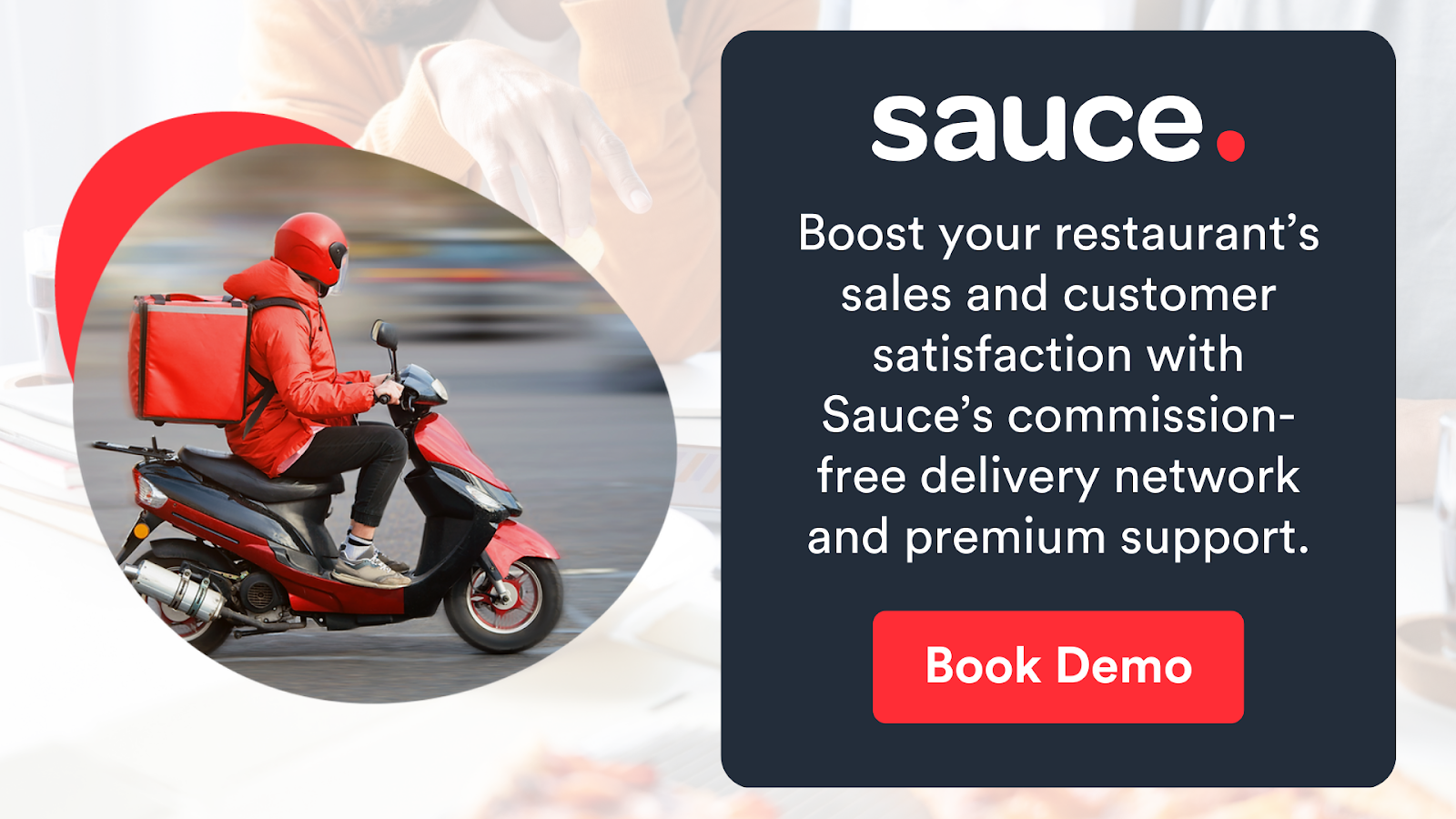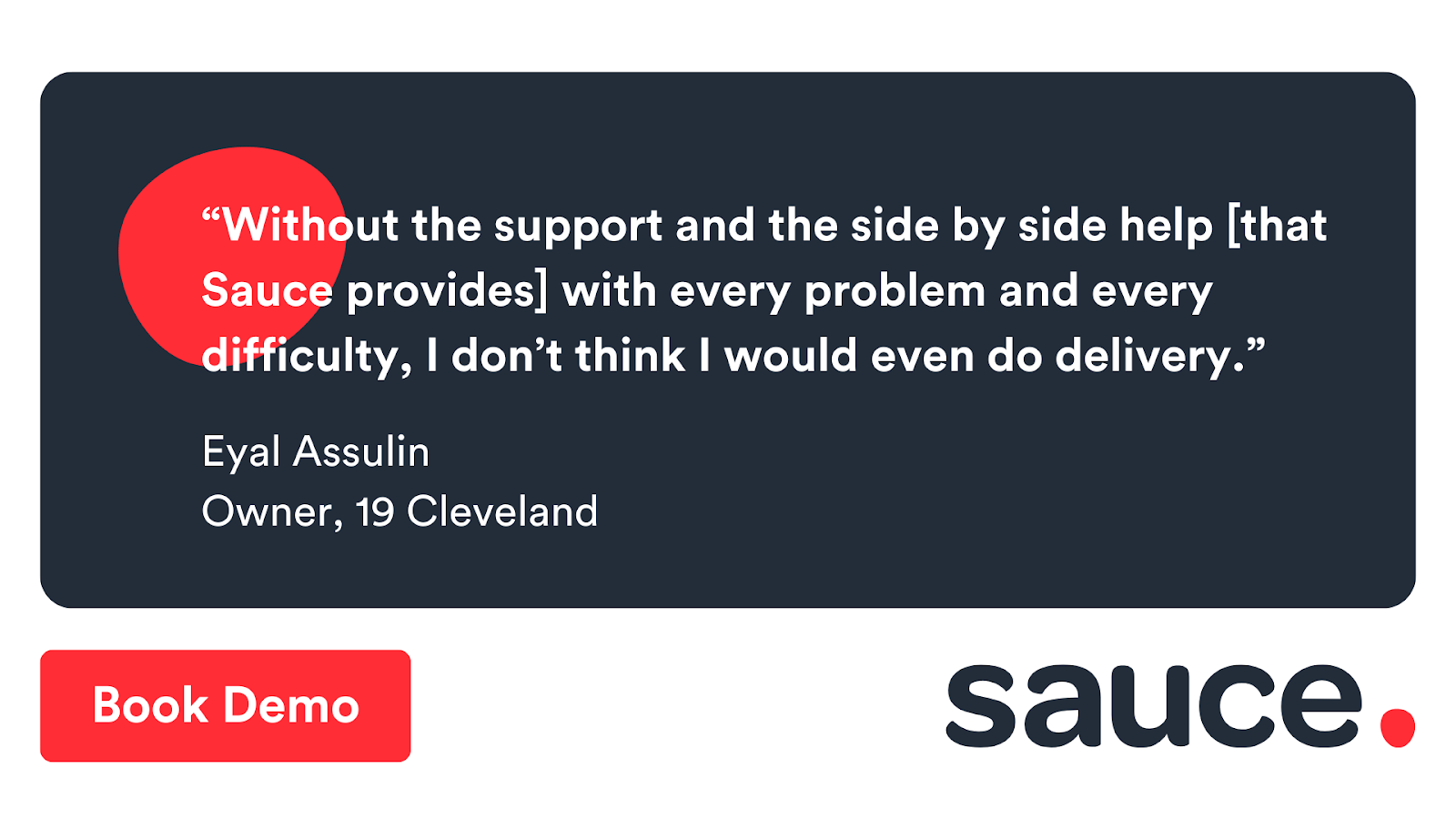
Key Takeaways:
-
Understand Commission Fees: Third-party platforms like Uber Eats, DoorDash, and Grubhub charge commission fees ranging from 15-30%, which can significantly reduce restaurant profit margins.
-
Control Over Customer Experience: Restaurants have limited control over customer interactions and brand representation when using third-party delivery platforms, impacting their ability to manage the dining experience.
-
Flexibility with Delivery Options: DoorDash and Grubhub offer restaurants the option to use their delivery drivers, providing more flexibility in managing logistics and customer service.
How do restaurants decide which delivery platform will benefit them most? With Uber Eats, DoorDash, and Grubhub dominating the market, it’s crucial to understand each platform’s strengths and challenges to avoid costly mistakes.
At Sauce, we pride ourselves on helping restaurants maintain their brand reputation and customer loyalty. Our commission-free online ordering system allows businesses to focus on delivering quality service while managing orders efficiently.
In this piece, we’ll explore the pros and cons of these major delivery platforms to help restaurants make informed decisions.
Understanding The Restaurant Delivery Market
The restaurant delivery market has rapidly evolved, with platforms like Uber Eats, DoorDash, and Grubhub playing a significant role in how restaurants reach their customers. These services offer restaurants access to a larger customer base, but this convenience often comes at a high price, with steep commissions and limited control over the customer experience. For many restaurants, balancing these benefits and drawbacks is a constant challenge.
Additionally, delivery services are now essential to staying competitive, especially in an age where convenience is a primary driver for consumers. However, with the increasing reliance on third-party platforms, restaurants risk losing control over customer relationships and brand representation. This is where alternative platforms that offer commission-free delivery solutions, such as Sauce, become particularly appealing.
Uber Eats: Pros And Cons For Restaurants
Uber Eats is a popular platform for restaurants, offering extensive reach and operational ease. However, as with any third-party delivery service, it has advantages and drawbacks. Let’s break down the pros and cons of Uber Eats in more detail:
Pros:
-
Large Customer Base – One of Uber Eats’ biggest benefits is its massive user base, both local and international. Restaurants gain access to millions of potential customers, helping increase order volume quickly. This wide reach is especially beneficial for restaurants in high-traffic areas looking to expand their customer base beyond their usual local clientele.
-
Seamless Integration – Uber Eats offers an easy-to-use platform that integrates smoothly with most restaurant systems. This makes managing orders and tracking deliveries more efficient for busy restaurant staff. The platform is also known for its real-time delivery tracking, giving the restaurant and customers visibility over the entire process.
-
Marketing Opportunities – Uber Eats frequently promotes restaurants through its app via sponsored listings, discounts, and special offers. Restaurants that participate in these promotions can see a significant boost in visibility and sales. This allows smaller businesses to compete with larger chains by appearing higher in customer searches and recommendations.
Cons:
-
High Commission Fees – Despite its benefits, Uber Eats charges high commission fees, often as much as 30% of each order. These fees can significantly cut a restaurant’s margins, making it harder to stay profitable. The cost may outweigh the benefits of increased exposure for smaller restaurants or those with tighter margins.
-
Limited Customer Interaction – Uber Eats handles much of the customer relationship, limiting how restaurants can interact with their diners. This restricts restaurants from collecting customer feedback directly or building loyalty. As a result, restaurants may need help maintaining strong customer relationships through the platform.
-
Branding and Reputation Control – When using Uber Eats, restaurants have limited control over their brand presentation and delivery experience. If an order is delayed or mishandled by the delivery driver, the restaurant often bears the brunt of the customer’s dissatisfaction. This lack of control can harm the restaurant’s reputation, even when the issue isn’t directly their fault.
DoorDash: Pros And Cons For Restaurants
DoorDash is another popular option for restaurants looking to expand their delivery services. Like Uber Eats, it offers benefits regarding customer reach and ease of integration but also presents challenges. Let’s explore the pros and cons of using DoorDash for restaurants in more detail:
Pros:
-
Large Customer Network – DoorDash has a wide customer base, which is especially strong in suburban areas where it outperforms competitors. Restaurants on DoorDash gain access to a broad audience, helping drive more orders. This can be particularly beneficial for restaurants outside of dense urban areas.
-
Flexible Delivery Options – One of DoorDash’s standout features is its flexible delivery options, which allow restaurants to use their own delivery drivers or DoorDash’s fleet. This flexibility lets restaurants manage delivery logistics based on their needs. It’s especially useful for restaurants that may already have a team in place for local deliveries but need extra support during busy times.
-
Promotions and DashPass – DoorDash offers promotions such as DashPass, a subscription service for customers that eliminates delivery fees on qualifying orders. Restaurants that participate in DashPass can see increased sales due to the appeal of lower fees for customers. This can drive loyalty and repeat business for participating restaurants.
Cons:
-
High Service Fees – As with other third-party platforms, DoorDash charges high service fees, typically 15% to 30%. These fees can affect a restaurant’s profits, especially for smaller businesses. Restaurants may struggle to justify costs, particularly when margins are slim.
-
Control Over Branding – DoorDash handles much customer interaction, meaning restaurants have limited control over how their brand is presented. Issues with delivery times or driver performance are out of the restaurant’s hands, but customers may associate negative experiences with the restaurant. This loss of control can affect long-term customer loyalty.
-
Customer Service Challenges – When problems arise with orders or deliveries, restaurants often find themselves stuck between DoorDash and the customer. Resolving complaints can be time-consuming, and with DoorDash acting as the middleman, it can be more challenging for restaurants to address issues directly. This can lead to frustrated customers and impact the restaurant’s reputation.
Grubhub: Pros And Cons For Restaurants
Grubhub is another crucial player in the restaurant delivery market, providing a platform with advantages and limitations. Let’s explore the pros and cons of using Grubhub for restaurant owners in more depth:
Pros:
-
Strong Market Presence in Urban Areas – Grubhub has a particularly strong presence in major cities, making it an attractive option for restaurants in densely populated areas. Its established customer base helps restaurants quickly access a large audience, which is especially beneficial for businesses aiming to grow their delivery orders in metropolitan areas.
-
Commission Flexibility and Lower Fees – Grubhub offers more flexibility in its commission structures than some competitors. Restaurants can negotiate better terms, particularly if they bring significant business to the platform. This flexibility can help restaurants manage their costs and maintain healthier profit margins.
-
Customizable Delivery Options – Grubhub allows restaurants to use their own delivery drivers or utilize Grubhub’s delivery network, giving flexibility in how orders are fulfilled. Restaurants can decide how best to handle logistics, depending on their resources. This is helpful for businesses that want to balance in-house deliveries with third-party support during peak times.
Cons:
-
Marketing Fees and Some for Services – Unlike other providers that charge a commission rate for each order, Grubhub applies a marketing fee ranging from 5% to 15%. Additionally, there’s a separate 10% delivery fee for using Grubhub drivers. For smaller restaurants, these fees can make it challenging to maintain a presence on the platform.
-
Limited Control Over Customer Interaction – Like other third-party delivery services, Grubhub manages much customer communication, limiting restaurants’ ability to interact directly with their customers. This means restaurants lose some control over the customer experience, which can affect their brand reputation. If an order is delayed or mishandled, customers often hold the restaurant accountable.
-
Saturation in Competitive Markets—In highly competitive markets, restaurants may need help standing out on Grubhub. Larger chains often dominate the top search results due to better visibility and more aggressive marketing, making it harder for smaller restaurants to compete for customer attention without paying additional fees for premium listings.
Cost Comparison: Which Platform Is The Most Affordable For Restaurants?
When comparing the costs of Uber Eats, DoorDash, and Grubhub, restaurants must consider various factors, including commission fees, delivery charges, and additional services. Here’s a breakdown of how each platform typically stacks up:
Uber Eats: High Commission Fees
Uber Eats is known for charging restaurants commission fees ranging from 15% to 30% per order. These fees can significantly impact profit margins, particularly for smaller restaurants that rely on every dollar. While Uber Eats provides extensive customer reach, the high fees may not always justify the return, making it a costly option for many establishments.

DoorDash: Variable Fees
DoorDash offers a more flexible fee structure, with commissions falling between 15% and 30%. Restaurants with high order volumes or long-term agreements may be able to negotiate lower fees, giving them more control over costs. However, these fees can still be burdensome for smaller restaurants or those new to the platform, similar to Uber Eats.
Grubhub: Negotiable But Still Costly
Grubhub offers more flexibility for restaurants to negotiate their commission fees, particularly for those generating high sales through the platform. However, instead of charging a commission for each order like other providers, Grubhub applies a marketing fee of 5% to 15%. There is also an additional 10% delivery fee for restaurants using Grubhub drivers. For smaller establishments, these costs can make it challenging to maintain a presence on the platform.
Direct Web Services
Uber Direct
Uber Direct allows businesses to use Uber’s fleet for same-day, local delivery without having to list their products on the Uber Eats marketplace. It’s a flexible service for companies looking to manage deliveries while maintaining their direct customer relationship. Restaurants using Uber Direct can integrate this service to handle logistics while keeping their brand front and center.
DoorDash Storefront
DoorDash Storefront enables restaurants to set up their online ordering system without DoorDash commissions. It acts as an eCommerce solution, where customers can order directly from the restaurant’s website. This helps restaurants maintain full control over their customer experience and brand while using DoorDash’s technology for delivery.
Grubhub Direct
Grubhub Direct is similar in concept, allowing restaurants to create online ordering portals. With Grubhub Direct, restaurants can avoid paying commission fees on orders made through their direct website, allowing them to retain more profits. This service helps restaurants manage orders independently of the main Grubhub marketplace while using Grubhub’s infrastructure for deliveries.
Final Thoughts
When navigating third-party delivery platforms, restaurants must think beyond immediate convenience and consider the long-term impact on their business. While Uber Eats, DoorDash and Grubhub provide valuable access to a wider customer base, restaurants must balance that benefit with the challenges of high fees, limited control over the customer experience, and potential impacts on brand reputation. Each platform offers unique advantages but requires thoughtful consideration to avoid diminishing returns.
Ultimately, success in the restaurant delivery landscape comes from finding a solution that aligns with your goals and values. Whether you choose a third-party platform or opt for alternatives like commission-free options, the key is to maintain control over your brand and customer relationships while maximizing profitability. Being strategic about delivery can lead to sustainable growth without sacrificing the quality and reputation your restaurant has worked hard to build.
Read also:
Frequently Asked Questions About Uber Eats Vs DoorDash Vs Grubhub
What are the key differences between Uber Eats, DoorDash, and Grubhub for restaurants?
Uber Eats offers a large global customer base, providing access to millions of potential customers. DoorDash excels in suburban areas and offers flexible delivery options. Grubhub is known for its strong presence in urban areas, particularly in major cities.
Which platform charges the highest commission fees?
Uber Eats generally has the highest commission fees, ranging from 15% to 30% per order. These fees can significantly impact restaurant profit margins, especially for smaller establishments with tighter budgets.
Can restaurants use their delivery drivers with these platforms?
Yes, DoorDash and Grubhub allow restaurants to use their delivery drivers. This flexibility can help restaurants control delivery logistics while benefiting from the platforms’ customer reach.
Which platform is best for small restaurants?
DoorDash and Grubhub may be better suited for smaller restaurants due to their flexible fee structures and delivery options. However, the best platform depends on the restaurant’s location, volume of orders, and target audience.
How do these platforms affect a restaurant’s brand control?
Using third-party platforms limits a restaurant’s ability to control customer interaction and how its brand is represented. Delivery issues or delays caused by the platform can lead to negative customer experiences, for which the restaurant may be held accountable.
What marketing opportunities do these platforms provide for restaurants?
Uber Eats and DoorDash offer marketing features like sponsored listings and in-app promotions, helping restaurants increase visibility. Grubhub focuses on enhancing restaurant presence in urban areas, though it may offer fewer promotional opportunities than its competitors.
Are the fees negotiable on any of these platforms?
Grubhub provides more flexibility in negotiating commission and marketing fees. Restaurants with high sales volumes may be able to negotiate better terms, helping them manage costs more effectively.
Which platform performs better in suburban areas?
DoorDash performs better in suburban regions, providing restaurants with broader customer access than Uber Eats and Grubhub. This can be a significant advantage for restaurants outside densely populated cities.
What are the common customer service challenges for restaurants on these platforms?
Restaurants often face issues with delivery delays or incorrect orders, but they have limited control over these problems. Customers typically hold the restaurant responsible, even when the issue stems from the platform’s drivers or logistics.
How can restaurants maximize profits while using these delivery services?
Restaurants can maximize profits by negotiating lower commission fees, participating in promotional programs, and balancing the use of third-party platforms with their delivery teams. Leveraging these strategies can help mitigate high service fees and improve margins.


